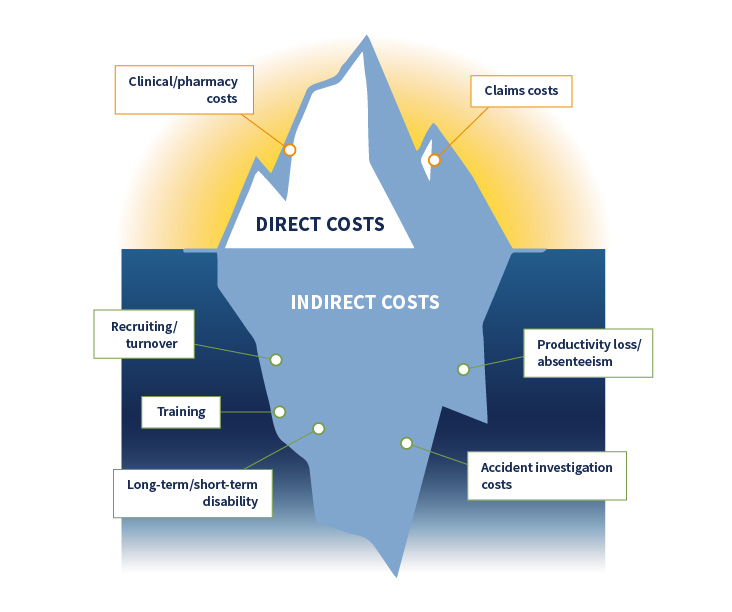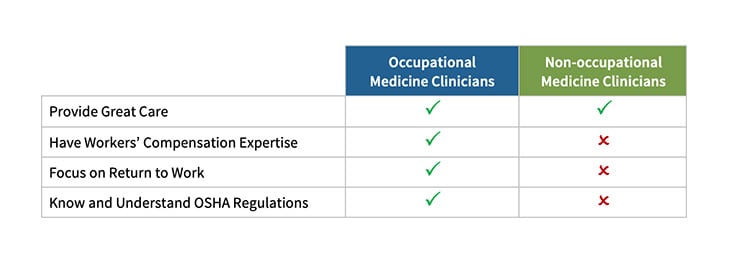
What Is Your Workplace Injury Care Plan?
By the time you finish reading this sentence, an employee somewhere in the United States would have just suffered a work-related injury. That’s because a U.S. employee gets injured on the job every seven seconds according to the National Safety Council. That equals more than 12,000 work-related injuries each day and roughly 4.5 million each year. Collectively, employers lose more than 100 million days of productivity each year due to employee injuries.
These staggering figures only reinforce how much of a burden work-related injuries continue to be for employers. Some of the most common work-related injuries include:
- Slips/trips/falls
- Muscle strains
- Injuries involving falling objects
- Repetitive-use injuries
- Back injuries
According to Bureau of Labor Statistics (BLS) data for 2017, 311,330 employees suffered work-related strains, sprains, and muscle tears; 227,760 employees were injured from falls, slips, and trips; and 148,780 employees suffered back injuries. More than 882,000 employees needed time off to recover, missing an average of eight days.
What is a work-related injury?
Defining a work-related injury is not as difficult as interpreting its definition. A simple definition would be a work-related injury is an injury arises out of work in the course of work. The types of injuries your employees may sustain depend on a number of factors, such as their line of work and its physical requirements.
The Impact of Work-related Injuries
Two important factors that impact work-related injuries are workers’ compensation laws and Occupational Safety and Health Administration (OSHA) guidelines. Workers’ compensation regulations vary by state, and discerning these rules can be a challenge; this is especially true for employers operating in multiple states. And every employer must maintain compliance with state and federal workplace health, safety, and environmental regulations. The consequences of noncompliance can be damaging to a company’s reputation and bottom line, as fines can mount based on the severity and frequency of violations.
Many employers don’t believe most injury care services are necessary. Some think a workplace injury claim is a matter best handled by their insurance provider, which helps to manage the costs associated with a workplace injury. This is a good thing, but here’s the problem – insurance only takes action after an injury occurs. If insurance is your only answer to injury care, you’re practically inviting an injury to occur. And although insurance absorbs some of the costs associated with a work-related injury, your company may still have to cover a significant portion of the total injury costs.
Direct Costs: The Tip of the Iceberg
According to National Safety Council (NSC) estimates, the average work-related injury (per medically consulted injury) costs around $39,000 in direct expenses. Various insurance studies reveal that the total cost of a work injury can range from four to ten times the direct cost once you factor in the indirect costs.
Workplace injury costs are often compared to an iceberg. The tip of the iceberg represents direct costs, which you easily see above the waterline. The part of the iceberg below the waterline represents indirect costs, which can be significantly greater in size.
Common Direct and Indirect Employer Costs Associated with a Work Injury

What is a workplace injury care plan?
A workplace injury care plan is a comprehensive set of guidelines a company follows to manage a work-related injury. An injury case can have many moving parts with multiple stakeholders. Your injury care plan keeps the process flowing with minimal confusion. It details a set of protocols established by the company for proper coverage and alignment when an injury occurs. Having a plan in place before, not after, a work-related injury occurs is the key to ensuring a positive return-to-work outcome and successfully managing a workers’ compensation claim.
Benefits of Workplace Injury Care
Injury care promotes early intervention. Helping employees recover from injury for prompt return to work is the overarching goal of workplace injury care. Having an injury care plan in place helps to facilitate the return-to-work process without delay, and returning your injured employees back to work as soon as possible is best for the employee and company. The injured employee can recover faster and resume normal work and life functions sooner. Productivity is regained, and injury case duration is shortened – both of which positively impact a company’s earnings and health care spending.
Injury care streamlines the workers’ compensation process. The workers’ compensation process can be convoluted. When you throw in the number of stakeholders, the waters become really muddy. Your injury care plan can help to streamline the claims process, ensuring all involved parties are aware of all matters pertaining to the claim. This can reduce or eliminate unnecessary steps that delay recovery and prolong the claims case duration.
Injury care improves communication between the employer and injured employee during a workers’ compensation case. A workplace injury care plan not only spells out what the employer and affected employee should do in the event of a work-related injury. It also sends a clear message to employees that their employer will be ready to help them navigate the challenging workers’ compensation process and recover promptly and safely.
Injury care boosts employee morale following a work injury. When an employee suffers a work-related injury, it’s not uncommon for morale to take a hit; however, when an employer mismanages an injury case, employee morale can really plummet. Not only is the injured employee affected; his or her colleagues may also be impacted.
An employer should never overlook the importance of employee engagement during an injury case. The better an employer keeps the injured employee in the loop, the better that injured employee will feel about his/her status with the company and the outcome of his/her claim. Furthermore, employees may observe how the company manages a work injury case to get a sense of what to expect should they get injured in a work-related capacity.
What to Consider When Devising an Injury Care Plan
To devise a comprehensive workplace injury care plan, first, consider your company’s pain points. Are certain injuries and illnesses common at your workplace? Do these injuries and illnesses coincide with health trends in your industry? If so, consider the makeup of your workforce and what provisions may be necessary for optimal employee performance and safety.
When thinking about injury care, factor in the risks associated with your company’s work environment and workforce duties. Make sure to consider company performance demands. Does your company have productivity quotas? If so, how do they impact employee injury risks?
What does an effective workplace injury care plan look like?
An effective injury care plan will clearly answer several important questions that arise during a work injury, including:
- Whom should an employee notify after an injury?
- Who documents the injury?
- Who submits the injury claim?
- Who authorizes treatment?
- Who is your workers’ compensation insurance carrier?
- Who will provide injury care and any necessary rehab services (applying state workers’ compensation laws)?
Developing an effective injury care plan requires expertise. Some companies have the size to justify having a risk/safety manager on staff and the budget to afford one. But regardless of company size or budget, it’s best to partner with an occupational medicine provider when creating or even revising an injury care plan.
Why partner with an occupational medicine provider?
Occupational medicine providers have a deep understanding of workforce health and safety, making them reliable resources to employers during the injury care planning process. Non-occupational medicine clinicians, such as general health practitioners or primary care physicians, have a basic understanding of workforce health. Occupational medicine is a medical specialty, however, and occupational medicine clinicians are specialists trained to treat occupational injuries and illnesses.
Occupational medicine providers understand what matters most to employers and the health of the employees they care for during a work injury, such as efficiently managing workers’ compensation cases while helping injured employees achieve rapid, sustainable recovery.

Adopting Preventive and Safety Measures with Injury Care
Having preventive and safety measures is an OSHA requirement. It’s also the best way to manage workplace injuries. Preventing workplace injuries involves learning the underlying causes of some injuries; therefore, an occupational medicine provider will take proactive steps to learn your company culture, which includes observing work surroundings and employees’ essential job functions. This typically requires an occupational medicine professional to tour your worksite(s) to assess workplace health and safety risks, and leverage that information to incorporate preventive measures. These measures could take the form of ergonomics or training opportunities to teach your workforce how to perform specific duties efficiently, minimizing injury risks.
Final Steps
So, you’ve partnered with an occupational medicine provider to devise a comprehensive injury care plan that will hopefully address your company’s workforce health pain points. Now what?
Build a relationship with your provider. Tour your provider’s medical facilities; get to know the staff who will care for your employees. Then, get your provider in front of your workforce. Your provider should visit your worksite(s) and conduct workforce health and safety training regularly. If your occupational medicine provider is only called upon or available after an injury occurs, how much effort is going into preventing injuries or nurturing a culture of workplace health and safety?
Make sure the injury care process is seamless. Along with ensuring your injured employees have easy access to quality care, your occupational medicine provider should also help to ease the administrative burden associated with workers’ compensation claims. When you need to view details surrounding a work injury case (e.g., treatment plan, clinical visits, claims status, etc.), you want information to be available without the constant back-and-forth. Having access to your provider’s employer portal should provide visibility into your work injury cases.
Share your plan. Another issue that can hinder the injury care process occurs when an employer carefully designs a plan but fails to properly communicate it with the entire workforce. It is important for employees with direct reports to be well-versed on the plan; however, your entire workforce needs to know the details. Getting injured on the job can be an emotional experience for an employee. Not knowing what will take place next will only frustrate an employee who is likely suffering physically, emotionally, and mentally.
Choose Your Occupational Medicine Provider Wisely
Work injuries can happen practically anywhere at any time. How an employer responds to these accidents can make all the difference. A workplace injury care plan is a company’s best chance at improving injured employees’ recovery potential. A well-designed plan enables employers to facilitate care while navigating the proverbial red tape of the workers’ compensation process. Creating and executing an effective injury care plan requires having the right occupational medicine expertise, resources, and experience at your disposal.
Concentra® is a leading occupational medicine provider. For the past 40 years, we have assisted thousands of employers of all sizes and industries with their workforce health needs. Along with our wealth of experience, we also offer exceptional access to care. Research reveals that care access – or the lack thereof – directly impacts patient recovery and return-to-work compliance. With more than 520 medical centers nationwide, we offer the convenience employers need. Each center has a medical staff specially trained to evaluate and treat a wide range of occupational injuries. Our clinicians are seasoned experts who help employers avoid medically unnecessary disability and eliminate medically unnecessary treatments, ensuring rapid, sustainable recovery is the focus of care.
If your company doesn’t have a workplace injury care plan, or if it has a plan that has room for improvement, we can help. Connect with a Concentra injury care expert or contact your nearby Concentra medical center to learn how.



